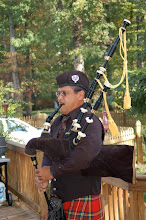



My bagpipe journey from obscurity to mediocrity. I started my search in September of 2005, after watching my brother play the Irish uilleann pipes in the summer. For an unknown reason, during my search, a practice chanter caught my eye and decided to purchase a
J. Dunbar Millenium 2000 Extra Long practice chanter and John Cairns Tutorials Volume 1-3 with CD. After three months of self study, I was ready for the big time, the GHB, or Great Highland Bagpipe.
After extensive research, I came up with the Dunbar P2 brass ferules poly (delrin plastic) as my first set of pipes. Why "poly"? Simple, low maintenance as compared to African blackwood and is not affected by rapid changes in heat and cold. Musical accuracy is the same as wood and bored to the same dimensions. I went and drove an hour to get my pipe the first week of December of 2005. I got it assembled, filled the bag, and tried to make the chanter play. Suddenly, I'm out of air, mostly important air that sustains life, self preservation has taken over and the search for a chair or something soft to cushion the fall was more important than sounding one or two notes from the chanter. Thus, the journey has began.
After a phone call from the seller on where I should start my lesson, he referred me to his student who has been playing for 15 years. I immediately e-mailed her and received a phone call the next day. With a little trepidation, I accepted the offer to start the next day, I said, "maybe three lessons instead of the four times a month", she said, that was acceptable, but, four times would be better.
My first lesson was an eye opener. The self teaching was excellent, to my ear, I actually learned some horrible techniques which has to be undone. The bright side, I can blow the chanter, better than the person who has not experienced the higher pressure to sound the practice chanter. I brought a micro recorder from the checklist. Now, learning to blow steady, keep time and breathing is a tall order. I would prefer just breathing, but, my new teacher was firm in doing this three things, and not the order I preferred. Although it is intimidating to be placed in a position where I thought my knowledge was sufficient. There is a great respect for a teacher who prefers perfection rather than accepting a minimum of effort. Reminds me of my drill sergeant in the Air Force, his way or his way. One learns later that there is a method to his madness, and I salute him for his guidance and giving me the discipline needed to be in the military. After taking home the assignment notebook and ordering the new book for the lessons to come, I accepted the challenge and was very excited to have finally something to help me move forward in this new endeavor.
The next lessons were fun, challenging and aggravating. Proper finger movements and understanding musical theory or both sometimes did not register. This was going to be a very long journey. I decided to sit back and enjoy the slow ride, short term and long term goals written down to help inspire and guide. Some techniques were learned easily and some took time, lots of it, sometimes in frustration, we had to learn something else and postpone the agony till another day. I have learned that playing slowly will make you faster later. Really!!!???? I like the phrase, “ Speed Kills”, I am reminded often, after all, none are really impressed except me, well, our cat was, he was just as fast running away from the nonsense coming out of the practice chanter.
Here is the tricky part, I have this bagpipe that I can't play, nor I'm allowed to play. What should one do? I know, cork the chanter stock and play the drones, tune the inside tenor to the outside and base to the outside tenor. Do this over and over till they all sound decent and you got yourself half a bagpipe. When your friends comes over, strike-in, get rid of the wawa sound, keep a steady sound, and draw some ohs and ahs. Looking at
Jim McGillivray's "Pipes Up" and Pipes Ready" for hours everyday for weeks really helped on how the pipes worked, Now, since I'm not allowed to play the chanter, how about corking the drones and play the chanter. It is very important to not have anyone close to hear the awful sound, the purpose here is not to challenge the high authority(teacher), but to start getting used to blow-squeeze-blow technique, right, I just could not wait to play the chanter. Even though the reed is soft, it is not easy to blow at all, but I made some sounds, it scared the cat, it does work. Now a chair or a bed close by is always a necessity, remember the lack of oxygen in the brain.
So, after one month, I came home with a goose. It has a practice chanter, blowpipe and a synthetic bag. This is where the blow-squeeze-blow technique is learned. It is also sensitive to pressure, over or under blowing will change the pitch. Now, after learning the first tune, it was such a joy to play it in the
"goose". Since the pipers memorize the tunes, the "goosers", namely me, will have to do the same. I memorized two tunes and was able to play it in the goose. After my forth tune and three months taking the lessons, it was taken away and finally my pipes was place in service with no drones, just the chanter.
After three months, we started with the outside drone only but moved on to two and all three within a month. It was a challenge to play the pipes for thirty minutes during the lesson. One does not show the teacher weakness(grasshopper). I built and used the manometer from
Andrew Lenz's site every day. If I could no longer blow with three drones, a cork goes in to the next, untill the chanter stock is corked and the lips could no longer seal. I also played just the drones and keep the level to within two inches and then work my way to one inch.
The best time to fiddle with the bagpipes is at night when no one is around. I took everything apart, rehemped, went to the internet and got a lot of info on adjusting the drone reeds. I also attended a workshop and learned chanter and drone reed manipulation. Here is
Ken Eller's chanter reed information. It took a while to balance the reeds and learned a lot on the way.












